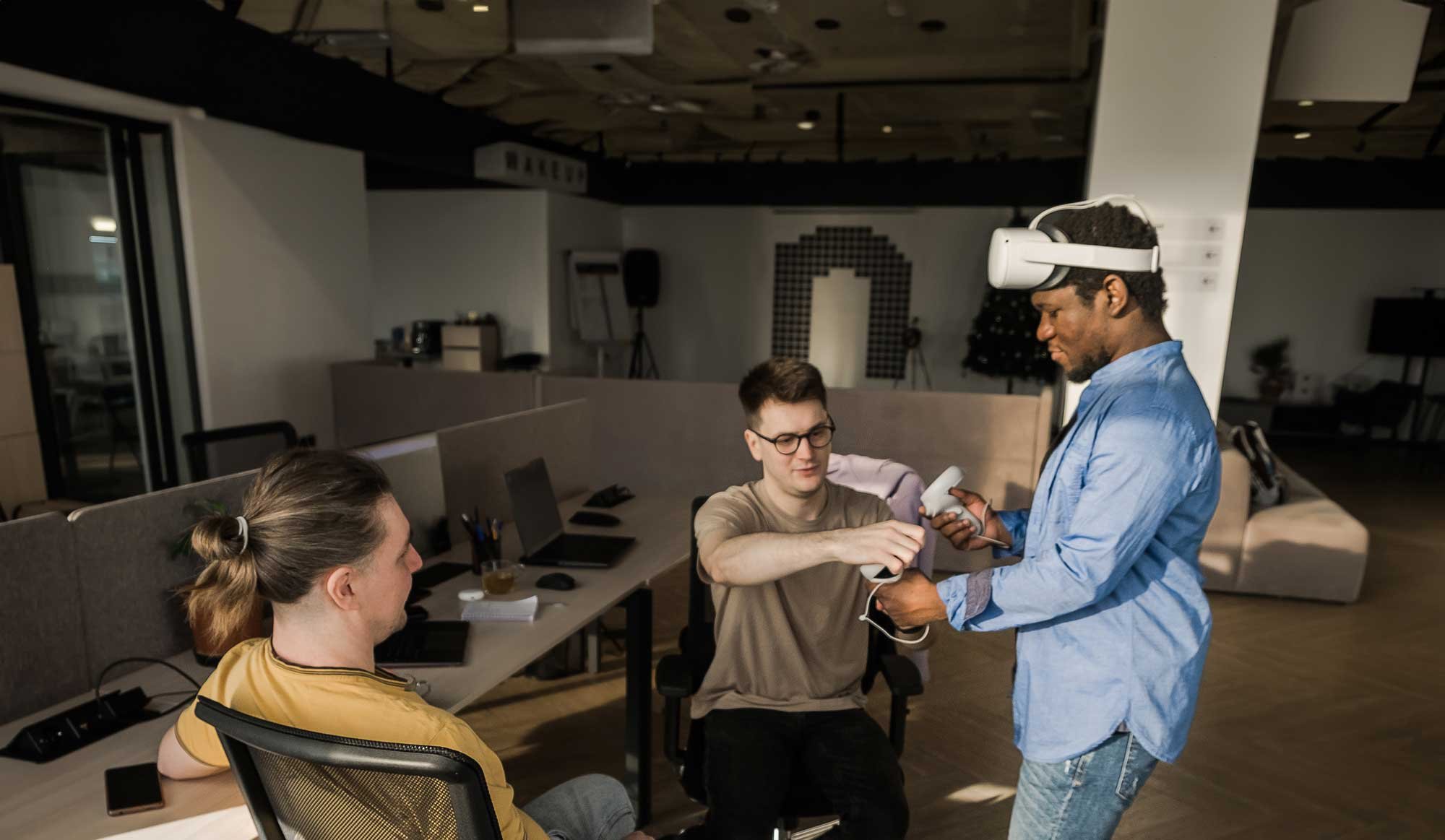XR for Your Business
Implement and See Impact
Getting your employees ready and measuring impact
Following best practices and choosing the right solution can help make your VR training implementation a success at every stage. But challenges will inevitably arise, commonly at one of three levels: organizational, employee, or technology. Here we offer numerous strategies to overcome these challenges.
After identifying a solution, take the steps below.
Successful adoption of new technologies often requires a mindset shift, and it’s critical to have an organizational strategy behind your adoption. Strong leadership support, an internal communication plan, and multiple channels for training provide a strong approach to driving sustainable changes by adopting VR training.
Advocate for internal buy-in among leadership. After you have identified and vetted the right training solution, take some time to get the buy-in you need from any other members of your leadership team first and then others at the company. VR adoption can take anywhere from three to six months to gain meaningful momentum and start having an impact on the business. In many cases, it will be more challenging to change hearts and minds than to address any technical aspect. Some strategies include:
- Come prepared with your why, resources that will be required (including time and costs), and the value you believe the training will bring to your organization. Leadership’s long-term buy-in will be critical to ensure the process has the time, financial resources, people and capacity, and energy it needs for long-term success.
- Name a leadership-level co-champion for the project, especially if they themselves are skeptical, to help show employees that everyone is aligned and supports the effort. It’s even better if co-champions agree to participate in the training alongside employees.
- If available, tie VR training to existing organizational strategic plans and employee expectations or competencies. One of the small businesses JFF worked with explicitly tied organizational leadership competencies it had already established to the learnings in its VR training, which helped provide clarity to both leadership and employees on what the new training would mean to them.
Create an internal communication plan. Once you have the green light to implement VR training at your business, it’s time to set out a clear plan and start socializing it internally. Creating a plan that is consistent and aligned to the organizational culture and that leverages multiple channels helps streamline expectations for all stakeholders and leads to increased employee motivation.
Some employees may be wary of anything additional they have to figure out and do. Your communication plan should address both the why and the how, to rally good energy and excitement before you introduce the actual VR headsets and hold the first training. A good second step is to ensure everyone at every level of your business simply puts a VR headset on so they can get the feel for the technology, including—and potentially starting with—the CEO. Demos in which one person is using VR and projecting their experience on a monitor or external screen can also help ease people in. Also remember the power of incentives—while training may or may not be mandatory at your business, additional incentives like sponsored lunches, raffles, or even face time with leadership can never hurt.
“We had a machinist who initially said that he didn’t have time for the training and he had to be persuaded to try it. Later, I spotted him in our training room—he was laughing and enjoying the training. He high-fived me after and said it changed his mind quite a bit.”
BUSINESS CHAMPION
Plan adequate time in advance. Those responsible for implementing the VR training will need adequate time to do so, and you will have to plan for it in advance. Account for time to set up the VR headsets, get to know the software, establish a schedule for training, recruit the employees, troubleshoot along the way, gather feedback and reflections, and track progress and KPIs. JFF’s pilots showed that, for the champion, this will require up to 10 hours per week during onboarding and early adoption, and up to five hours per week for maintenance and coordination on an ongoing basis during training periods.
As with any new technology, it’s important that the momentum picks up and the benefits start to be felt and seen before you let your foot off the gas. Consistency and follow-through are critical. Make sure you have a three- to six-month runway to allow the business the time it needs to implement the VR training without being pulled in too many directions.
Take on training without impacting productivity. Are there times during the year when work is slower? Are there times when you can more easily have other employees cover for each other? These are better windows to implement training. In small businesses, capacity for training is often limited, and it can be difficult to carve out time for employees to participate in training without taking away energy and resources from daily operations.
Plan to help employees access headsets. Headsets are necessary for VR, so your employees need easy access to them. This can present some challenges, for example, if a business has a distributed workforce where employees are not regularly in a central office, or if employees frequently work on site, such as caregivers working out of clients’ homes or a crew working on different construction sites. Your business also needs to ensure that headsets are secure and safe, especially if employees are borrowing them for certain periods of time.
Make a technology support plan. VR solutions require a strong and consistent internet connection to function. Check with your local internet provider or IT specialist to ensure you have the bandwidth available. One of the businesses in our pilot was on a mountaintop, so it had to mitigate a weak internet connection by working with employees to complete training elsewhere. You’ll also need resources to assist your employees with any technical troubleshooting with the headsets.
Define success. Like all other initiatives, setting clear, measurable goals is crucial for VR training's success. VR training is an investment in your business, so you need to understand the ROI and work backward from there. As mentioned earlier, align your VR training goals with the other goals of your business, so everyone understands that the effort will have a direct impact on the business. The more you can tie your training goals to your business goals, the more likely training will succeed.
Identify KPIs. Common KPIs businesses can achieve with VR training include:
- Reduced time spent training and higher engagement with training.
- Reduced errors made on the job.
- Increased employee confidence levels in performing specific tasks.
- Increased employee communication skills with one another and customers.
“Our employees are now more proactive in tackling issues. Management feels more confident to find solutions proactively and problem solve. I’m seeing a different level of maturity in our employees after this training in soft skills. This is really new.”
BUSINESS CHAMPION
VR can provide long-term cost savings and benefits to many businesses. It’s important, though, to know your specific business goals and track metrics accordingly to be able to see the impact VR is having for your business in particular.
Many VR software companies provide built-in assessments to help evaluate the user’s knowledge of a specific skill set or level of confidence after completing training. While it’s helpful to see how an individual is progressing in skill development, it’s important to compare business KPIs before and after using VR to see how it impacts an employee’s performance on the job—i.e., how they are applying those skills to their job—and in turn how that is impacting the business overall.
Learn from others. Reviewing case studies to understand the impact and benefits businesses have gained from VR can help you identify what goals to measure and track and determine what type of VR training content makes the most sense for your business. We encourage businesses to ask VR solution providers for such case studies and examples of how other customers have benefited from their training solutions. The following case studies published by VR training providers highlight a range of KPIs businesses were able to improve using VR training:
- Strivr case studies: Includes several case studies in a variety of industries (financial services, manufacturing, retail, logistics, technology)
- Interplay Learning case studies: Includes several cases studies of small businesses in the skilled trades industry
Consider the following best practices to help ensure successful implementation at your small business:
Align content to your industry. Content that is aligned to an organization’s own industry is more consumable and relatable for employees, which reduces the time it takes to build skills. Consider industry-aligned content to build buy-in for VR training at your business particularly if this is your first time implementing VR.
“After completing the training, a clinical lead said, ‘I’ve been doing the work all wrong all of these years,’ and went to a former patient and said, ‘I’m sorry I cared for you in this way. I understood after I did this training and experienced it through your eyes.’”
BUSINESS CHAMPION
Identify a provider that meets your language needs. Given where the overall VR market is, most solutions at this time do not have language options or translations. Small businesses in particular may find this a challenge. If you use an English-only solution, ensure you can provide support for any employees who need it.
Pay employees for training. We strongly recommend that all employees be paid for any hours of training, especially if required. Check your local and state guidelines to ensure compliance with any related policies.
Offer multiple modalities. Each employee learns a little differently from the next. Offering a variety of learning options with VR is more inclusive and creates a safe space for all employees to participate. Offering in-person and asynchronous training, or a combination of both, builds trust with employees.
Create in-person touch points. Providing opportunities for people to discuss what they learned from the training creates accountability, deepens the impact of the experience, and allows for team building.
Solicit and monitor feedback. Input from your employees—about VR, training content, and how it gets applied—is a vital part of the learning process and leads to a more successful implementation. Feedback also provides insights about where gaps in experience, exposure, or learning may still exist, presenting an opportunity to provide more training.
Overall, remember to celebrate progress and view setbacks as opportunities to learn. Your business’s first exposure to XR technology will likely affect awareness and exposure more than long-term people metrics like retention or long-term company metrics like profit. Getting people used to VR as a training modality is a huge first step, setting you up for continued learning and planning moving forward.
How to Support Small Businesses in Your Community as a Small Business Service Provider
- Add Capacity. Do some of the heavy lifting—vetting solution providers can help small businesses determine who might offer the best-fit solution for tackling their unique needs.
- Make the Case. Help make the case for businesses so that eager employees, managers, and company leaders can make the case to others at their business. This can be done through written materials and anecdotes, and by creating a community of peer advocates who can share their experiences.
- Run a Pilot. If capacity allows, consider running a pilot VR training program involving multiple businesses to lighten the lift on any individual business trying to figure it out on its own. JFF would be delighted to partner with you.



.jpg?width=2000&name=azwedo-l-lc-Z6UFA9MxTl0-unsplash%20(1).jpg)

